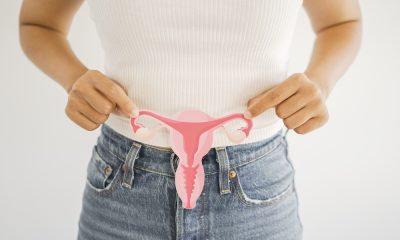Wellness
Evidence shows link between endometriosis and physical traumatic experiences

An international study has found new evidence linking traumatic experiences and stressful events with endometriosis – revealing that the condition appears to be closely linked to trauma involving contact, such as in physical abuse or sexual assault.
Through genetic analysis, the researchers found that this relationship seems to be independent of genetic predisposition to endometriosis. The findings could be helpful to take into account when diagnosing endometriosis, which affects 190 million women of reproductive age worldwide.
Dora Koller, first author of the article and researcher at the Department of Genetics, Microbiology and Statistics of the UB’s Faculty of Biology, notes that: “While psychological trauma has been associated with endometriosis, to date, there has been little information on the role of the type of trauma and genetic predisposition.
“These results challenge established paradigms by uncovering shared genetic mechanisms linking endometriosis with post-traumatic stress disorder and other types of trauma, while providing new insights into how different types of traumatic events are associated with the disease.”
The study was based on observational and genetic data analyses from 8,276 women with endometriosis and 240,117 controls in the UK Biobank, a biomedical database containing anonymised genetic, lifestyle and health information, as well as biological samples from people in the United Kingdom.
“Our study shows that people with endometriosis were more likely to report having experienced certain traumatic events compared to healthy people,” said Koller.
For example, people with endometriosis were 17 per cent more likely to have witnessed a sudden death, 16 per cent more likely to have experienced sexual assault in adulthood and 36 per cent more likely to have received a life-threatening diagnosis.
To explore the connection between different types of trauma, the researchers conducted a latent class analysis, a research tool that unravels hidden clusters in a dataset.
“More cases of endometriosis could be linked to emotional, physical and sexual trauma,” said Koller.
Post-traumatic stress disorder and child abuse
The genetic analyses in the study consisted mainly of a genome-wide association study (GWAS) of endometriosis and also an analysis of the interaction between traumatic events and the polygenic risk of endometriosis, an approach that assesses the combined impact of multiple genetic variants on the development of a disease, rather than focusing on a single gene.
The results of these analyses have revealed that the disease correlates genetically with several trauma-related conditions, with the strongest evidence being linked to post-traumatic stress disorder and child abuse.
Koller said: “Childhood trauma, for example, feeling hated by a family member as a child and being physically abused by the family, was also linked to endometriosis, highlighting the potential role of early adverse experiences in shaping the risk and progression of endometriosis.”
Other genetically inferred relationships included situations related to having someone who could take study participants to the doctor during childhood.
According to the researcher, this would be “especially important” in the case of endometriosis, since having caregivers who ensure access to medical care during this stage of life may influence stress resilience and care-seeking behaviour, reducing the likelihood of under-diagnosis and under-treatment.
“People who lack caregiver support may be less likely to defend their health,” Koller said.
Mechanisms which do not depend on the genetic predisposition
The results also show that the relationship between the genetic risk of endometriosis and trauma does not seem to be due to a direct interaction between genes and environment, but would be explained by correlations between genes and environment.
That is, for example, people with a certain genetic predisposition may be more likely to experience or remember certain traumatic events, which could influence their risk of developing endometriosis.
“Based on the reclassification proposed by Hugh Taylor – co-author of the current study – of endometriosis as a chronic systemic disease with manifestations outside the reproductive tract, our findings highlight how childhood and adult trauma may contribute to the pathogenesis of endometriosis with mechanisms that appear independent of the genetic predisposition,” said Koller.
An early diagnosis strategy
The associations identified between endometriosis and traumatic events are consistent with a previous study by the same research team that linked the disease to depression, anxiety and eating disorders.
These combined findings highlight the importance of assessing the physical and mental health of patients with endometriosis.
“Although the results need to be confirmed in other cohorts, they suggest that we may be able to design early endometriosis screening programmes that consider not only genetic factors, but also a history of physical trauma or other risk factors. This would help to identify and treat the disease more comprehensively and effectively,” Koller said.
Insight
Uterine fibroids linked to increased heart disease risk
Opinion
Acceptable use vs exploitation with ‘free’ digital health tools

By Wolfgang Hackl, CEO, OncoGenomX Inc., Allschwil, Switzerland
“Free” digital health tools are rarely free. In most cases the user – healthy or patient – pay with something far more valuable than a subscription fee: intimate, high-granularity data about their bodies, behaviours, and vulnerabilities.
As digital health platforms grow into critical infrastructure for care, research and consumer wellness, a central ethical question has become unavoidable: When does data use enable public good – and when does it cross the line into exploitation?
Across global literature, five bright lines consistently separate acceptable data use from irresponsible or predatory practices: transparency, proportionality, patient control, fairness in value sharing, and protection from harmful downstream uses.
When any of these conditions are missing, offering a “free” tool can become a mechanism for extracting disproportionate value from users while outsourcing the risks back onto them.
The ethics of the deal: what healthy users and patients expect from data sharing
Empirical studies continue to show that most people are willing to share health data – but only conditionally.
Individuals support sharing when data clearly contribute to research, treatment innovation, care quality, or public health.
Trust erodes quickly when data are used for insurance underwriting, targeted advertising, pricing segmentation, or other uses that may limit access to care or worsen financial vulnerability.
What users consistently expect is:
- Clarity – Who sees which data, for what purpose, and for how long?
- Control – Granular permissions and an easy, meaningful opt-out—not buried legalese.
- Security – Strong technical safeguards and independent oversight.
- Benefit – A reasonable expectation that sharing data contributes to something of social or personal value.
Several commentaries argue that requesting personal data without a realistic prospect of benefit—not even transparency about outcomes – is itself problematic because it treats contributions as limitless and one-sided.
The ethical legitimacy of data collection depends on demonstrating respect for the individual’s time, autonomy, and moral investment in the health system.
Exploitation risks in the “free” digital health economy
The most serious risks emerge when a free tool’s business model is fundamentally misaligned with users’ health interests.
Technical audits of reproductive health, wellness and symptom-tracking apps show a common pattern: extremely broad data collection, unclear purpose boundaries, permissive permissions, third-party tracking, and vague categories such as “other information.”
These form the architecture of a data extraction engine rather than a health intervention.
Even apps claiming to hold only de-identified data can open the door to harms, because de-identified health behaviour signals are immensely valuable for:
- Risk scoring and pricing (insurance, consumer credit, employment screening)
- Targeted advertising (particularly manipulative or sensitive targeting)
- Behavioural profiling (including in politically or legally hostile environments)
- Opaque algorithmic triage or eligibility decisions
In such cases, the user’s data generate significant commercial value yet expose the individual to disproportionate risks – a classic hallmark of exploitation.
The “paying twice” problem: who benefits from population data?
Growing debate around emerging health data spaces – especially in Europe – frames exploitation not only as a privacy issue but as a structural market failure.
Health data are immensely profitable. When commercial actors derive outsized value from population-level datasets without mechanisms to share those gains back with the public, patients effectively “pay twice”:
- First with their data, which fuel product development, risk models, or AI systems.
- Then again through the high prices of those very products and services.
This disconnect – value extracted privately, risk borne publicly – undermines the legitimacy of the entire ecosystem.
Scholars argue that without reciprocity mechanisms (affordability conditions, public-good obligations, reinvestment requirements, open reporting), population data becomes a one-way transfer of wealth from patients to shareholders.
What acceptable data use actually looks like
Across policy, legal, and ethics scholarship, a consistent set of practical markers has emerged to distinguish responsible data practice from exploitation:
1. Transparency and comprehension
Not merely posting a 30-page privacy policy, but communicating data practices in human-readable language.
Dark patterns, forced consent, or ambiguous categories (“other information”) are widely flagged as red flags.
2. Data minimisation and proportionality
Collect only what is needed for the clear, stated purpose. Health apps that request location, contacts, device IDs, access to photos, or continuous background tracking must justify why such access is necessary for patient benefit.
3. Meaningful patient control
Granular consent, revocation options, and controls that do not punish users for refusing unnecessary data sharing.
Users should be able to say “yes to research but no to advertisers” without losing core functionality.
4. Demonstrable public benefit and reciprocity
Data-driven innovation should return value to the communities who generate the data—through equitable access, affordability, improved care pathways, or transparent reinvestment in health systems.
5. Prohibitions on harmful downstream uses
Platforms must enforce technical and contractual safeguards against uses that could lead to discrimination, exclusion, legal jeopardy, or personal harm – especially in sensitive domains such as reproductive health, mental health, and genomics.
6. Strong security and independent governance
Routine audits of algorithms, permissions, data flows and third-party access; oversight bodies empowered to block or penalise inappropriate secondary use; and governance models built around public accountability.
When these markers are present, data use—whether in research, diagnostics, early detection, or population analytics – can be socially valuable and ethically defensible.
When they are absent, value extraction becomes the default.
Where the industry must go from here
For global Health Tech companies, the stakes are high. Trust is not just a compliance objective – it is a competitive advantage.
As jurisdictions develop new frameworks for data spaces, AI governance, and platform accountability, Health Tech innovators must rise to higher ethical standards than the minimal legal baseline.
A responsible future for digital health requires that “free” tools come with:
- Clear limits on what patient data can be used for
- Oversight mechanisms to validate secondary uses
- Fair distribution of the benefits of data-driven innovation
- Design practices that prioritize patient autonomy and safety
Anything less risks widening inequities, damaging public trust, and ultimately undermining the legitimacy of digital health itself.
The real test of the industry is simple: Are we using patient data to empower people – or to exploit them?
The next decade of digital health will be shaped by how honestly and rigorously we answer that question today.
Insight
Canada targets US$37bn femtech opportunity

Vancouver forum brings policy, industry and health leaders together to tap Canada’s US$37bn femtech opportunity.
The 2025 Femtech Canada Forum brought together representatives from policy, academia, industry and global health organisations to address what organisers describe as a US$37bn economic opportunity for Canada’s economy through women’s health technology.
Femtech Canada announced it will join the United Nations Population Fund’s Equity 2030 Alliance as a member and co-lead of the Technology Cluster, becoming the first organisation to assume a cluster co-lead role within the alliance.
The Vancouver event, hosted by Femtech Canada with title sponsor Sun Life and event sponsor Deloitte Canada, focused on aligning research, policy and commercialisation efforts to address gender health disparities.
“We are excited to welcome Femtech Canada as a co-lead of the Technology Cluster,” said Dr Nigina Muntean, chief of the innovation and transformation branch at UNFPA. “Their leadership will help accelerate gender-equitable technology development and strengthen collective efforts to advance women’s health and wellbeing worldwide.”
Andrea Guest, senior manager at Femtech Canada, said the organisation was “honoured” to join the alliance. “By aligning our ecosystem work with the Alliance’s global mandate, we can accelerate the design and adoption of technologies that truly serve women’s health.”
The forum featured several report launches addressing barriers to women’s health innovation in Canada. Deloitte Canada and the IWK Foundation unveiled “The Case for Advancing Women’s Health in Canada”, which calls for updates to Canada’s Women’s Health Strategy and outlines policy gaps and economic opportunities.
Zahra Jivan from Deloitte Canada and Heather Creighton from the IWK Foundation presented recommendations for driving equitable outcomes and what they described as unlocking national prosperity through women’s health investment.
PeriPharm and Duchesnay released a white paper documenting two decades of market access challenges for women’s health medications in Canada. Catherine Beauchemin and Maggie Dong of PeriPharm presented the findings, highlighting regulatory barriers and proposing strategies for reform.
A discussion between Dr Lori Brotto from the Women’s Health Research Institute and Hilary Kilgour from Audaxa Ventures examined pathways from research to commercialisation for evidence-driven entrepreneurs in femtech.
The closing panel, moderated by Laura Maxwell from Sun Life, included Dr Angela Kaida from the Canadian Institutes of Health Research, Jessica Chalk from myStoria, Mallorie Bronfman-Thomas from the UNFPA’s Equity 2030 Alliance, and Stephanie Gan from Health Emergency Readiness Canada.
Panellists discussed embedding gender equity throughout the innovation lifecycle, from research and product development to commercialisation. They emphasised the need for inclusive data practices, investment and stronger pathways for bringing women’s health solutions to market.
“This Forum helps us form the roadmap to move from talk to tangible action,” Guest said. “We’re done talking about ‘potential’ and are now focused on the collective work to make Canada’s femtech advantage a world-leading reality.”
The annual forum rotates between Canadian cities to support regional and national growth in the femtech sector. Organisers positioned women’s health innovation as what they called one of Canada’s greatest untapped opportunities for innovation, productivity and inclusive growth, requiring national coordination and strategic positioning as an economic growth driver.
-

 Diagnosis4 weeks ago
Diagnosis4 weeks agoResearchers develop nasal therapeutic HPV vaccine
-

 News4 weeks ago
News4 weeks agoWoman files lawsuit claiming fertility clinic ‘bootcamp’ caused her stroke
-

 News2 weeks ago
News2 weeks agoDoctors push back on ‘data-free’ ruling on menopause hormone therapy
-

 Entrepreneur2 weeks ago
Entrepreneur2 weeks agoInnovate UK relaunches £4.5m women founders programme
-

 Menopause4 weeks ago
Menopause4 weeks agoSleep-related disorders linked to hypertension in postmenopausal women
-

 Hormonal health4 weeks ago
Hormonal health4 weeks agoSelf-guided hypnosis significantly reduces menopausal hot flushes, study finds
-

 Opinion1 week ago
Opinion1 week agoFemtech in 2025: A year of acceleration, and what data signals for 2026
-

 Opinion2 weeks ago
Opinion2 weeks agoWhy women’s health tech is crucial in bridging the gender health gap



























